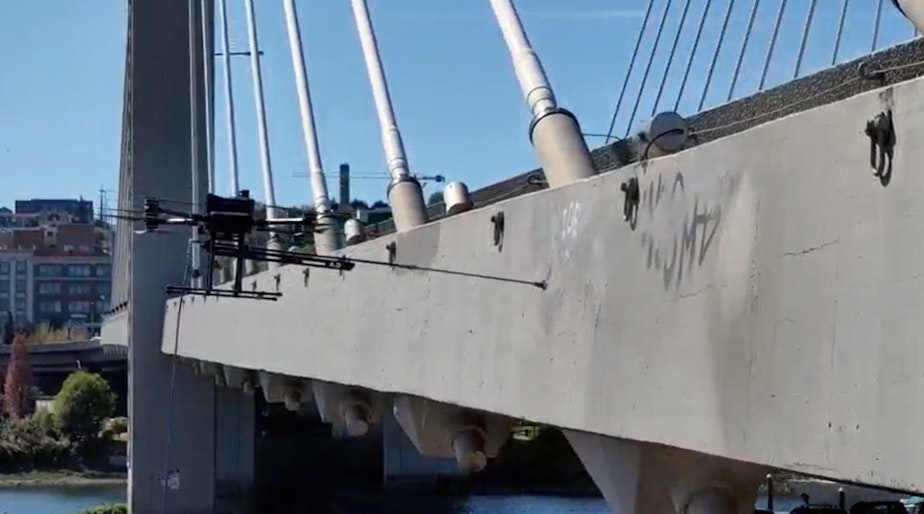Look, up in the sky! It's a drone ... painting over graffiti in Washington state

The Washington State Department of Transportation has begun experimenting with drones to take on graffiti along state roads. It's just one part of a larger experiment using cameras to tackle graffiti between Tacoma and Seattle.
"This is a pilot program to determine the benefits and challenges of using drone technology for graffiti removal, including whether it requires fewer staff to be working near active traffic and at high elevations requiring fall equipment," said WSDOT spokesperson Tina Werner.
RELATED: Pizza delivery via drone could soon be coming to Seattle and Tacoma
It's the first time a public agency has deployed drones to paint over graffiti, as far as WSDOT knows. The department is currently conducting a pilot that sends drones, equipped with a spray paint nozzle, to cover up graffiti in difficult spots, like bridges or very high up on walls. The drones have a hose that feeds paint to it from the ground. An operator (pilot) takes care of the rest.
The paint — called "DOT gray"— is water-based latex.
The drone-painting pilot is part of a larger effort approved by the state Legislature earlier this year. Lawmakers passed a bill aimed at mitigating graffiti, with two areas of focus. One is the drone pilot. The second is to "investigate and test improvements to systems capable of identifying persons who damage property with graffiti." According to WSDOT, $1 million was budgeted for this bill, a "small portion" of which is going toward the drone program. The remaining funds are being used to look into traffic camera tech that could monitor for graffiti removal.
RELATED: Seattle will start enforcing its anti-graffiti law again
"A large portion of the pilot program focuses on potential solutions for upgrading the state’s existing traffic camera infrastructure ... to determine if higher-resolution cameras, tracking software, and additional camera placements would enhance our ability to detect graffiti activity," Werner said, noting that WSDOT is in the "very early stages" of this program.
"WSDOT’s current cameras are designed and located to monitor traffic," she added. "If cameras were to be used for graffiti surveillance, the camera resolution and locations (additional focus on retaining walls, bridges, etc.) would need to be upgraded. Also, additional tracking software upgrades would be required as well as staff training."
These efforts are specifically aimed at I-5 between Tacoma and Seattle, as well as the north Spokane corridor. A report on the results of the pilot is due to lawmakers in December.
Spray painting drones
WSDOT credits Mike Gauger with the drone idea. He works with the department's maintenance crews in Tacoma. While the Legislature approved funding for the program in 2024, Gauger and WSDOT have been looking into drones' potential since 2023.
Gauger, essentially, had a "there's got to be a better way" moment while tackling some graffiti on Olympia's Capital Boulevard Bridge two years ago. WSDOT usually sends special trucks (called UBITs) to take on such jobs. They're big trucks with cranes that can lift workers over the edge of bridges or high up where they can paint over graffiti. The state only has six of them, and Werner pointed out that it puts crew members at risk.
Drones seemed like a good idea to try. WSDOT had already been using drones to inspect under bridges and monitor other road maintenance.
Gauger found one drone company, Aquiline, willing to experiment with the idea. The first try failed. The second attempt appears to be working. Now, maintenance crews will try sending the drones to locations in Tacoma and Olympia. They'll only be used in closed work zones, and possibly in areas where traffic is is managed and slowed down. Technically, it's illegal to operate drones over traffic.
According to WSDOT, the state spent more than $815,000 in 2023 to remove graffiti across Washington, which covered 10,300 hours of labor and 700,000 square feet of space along highways. The department noted that it is still not enough to handle all of the graffiti out there.

